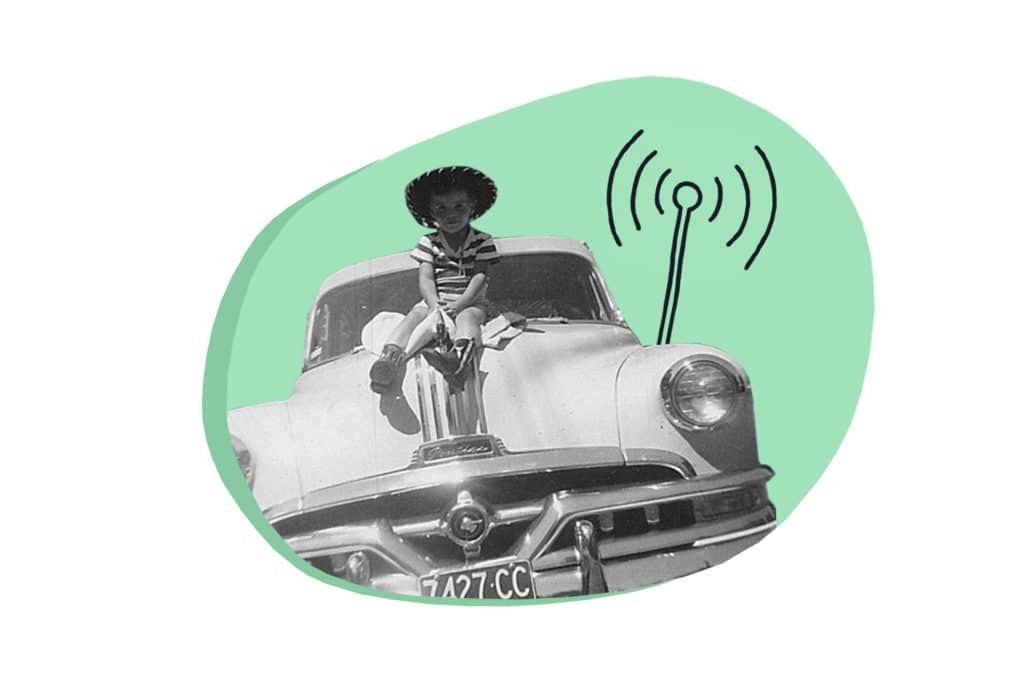The widespread availability of consumer internet access highlights how deeply technology has integrated into our everyday routines. What began as a specialized communication system in the late 1970s has exploded into a global phenomenon, boasting an astounding 4.3 billion active users by 2021. It’s not just computers and smartphones anymore; we expect all sorts of devices to be internet-enabled, and even everyday places like coffee shops commonly provide free WiFi. It’s safe to say, accessing wireless internet virtually anywhere is now a reality.
Despite this pervasive connectivity, the question of how to get WiFi in your car remains a hot topic online. Whether you’re actively seeking in-car WiFi solutions or simply curious about the reasons behind this demand, this guide will provide you with comprehensive answers.
Why is In-Car WiFi Desirable?
The desire for in-car WiFi stems from a variety of needs and preferences. Here are some of the primary drivers:
- Staying Socially Connected: Like the telephone and other groundbreaking communication technologies before it, the internet is invaluable for maintaining global connections. While you might not feel completely disconnected without in-car internet, having consistent access offers significant advantages.
- Enabling Remote Work: A significant portion of the demand for mobile WiFi solutions comes from the growing remote workforce. With remote work experiencing a steady surge – projected to increase by 87% by 2025 compared to 2020 – in-car internet is becoming less of a luxury and more of a necessity for these professionals.
- Embracing Tech Culture: For some, the allure of cutting-edge technology is reason enough to adopt it. Installing WiFi in a car, from this perspective, can be seen as an expression of tech enthusiasm and appreciation.
- Supporting a Mobile Lifestyle: The freedom to roam and the ability to work or stay entertained from anywhere are highly valued by many. For those who embrace a dynamic lifestyle, a connected car is simply another way to enhance their mobility and flexibility.
The Advantages of Having WiFi in Your Vehicle
Even if the above reasons don’t directly resonate with you, there are still compelling benefits to having internet access while on the road.
- Increased Autonomy: While public WiFi hotspots are widely available, there’s a sense of independence in knowing you have your own reliable connection, without relying on public networks.
- Enhanced Security: A personal in-car WiFi setup that you manage is considerably more secure than using public WiFi networks at places like cafes. Public networks are often less secure and can expose your data to risks.
- Software and App Updates On-the-Go: Keeping your device software and apps updated is crucial for both security and optimal performance. In-car WiFi allows you to seamlessly download updates while traveling, ensuring your devices are always current.
- Extended Device Battery Life: While finding how to get internet on a laptop while traveling using phone hotspots might offer a few hours of connectivity, a dedicated in-car WiFi router provides virtually unlimited usage without draining your phone battery.
- Greater Convenience: In an age where cords and cables are becoming obsolete, in-car WiFi contributes to a cleaner, more streamlined tech experience within your vehicle.
- Real-Time Information Access: In today’s fast-paced, information-driven world, staying informed and connected is essential. In-car WiFi ensures you never miss important updates, news, or communications, regardless of your location.
Key Considerations for Roadside WiFi
Before exploring the technical aspects of setting up in-car WiFi, it’s important to consider potential challenges:
- Coverage Limitations: Even the most advanced in-car WiFi solutions depend on mobile network coverage. “Anywhere” internet access is still limited by the reach of cellular networks, and connectivity can be spotty in remote areas.
- Hardware Practicality: Some theoretical options for in-car internet, like satellite internet, are simply not practical or user-friendly for everyday car use due to equipment size and complexity.
- Cost Implications: While becoming more affordable, mobile internet access still isn’t the cheapest option. If you plan to use in-car WiFi extensively, especially while traveling, understanding how to avoid roaming charges is important for cost management.
Depending on your specific needs and circumstances, these challenges might be a small price to pay for the convenience of in-car internet. With the right 4G LTE device, many of these drawbacks can be minimized or eliminated. Here’s a detailed look at your options for getting WiFi in your car and making the best choice.
Further Reading: Internet on the Road: How to Be Connected While Travelling in Your RV?
Methods to Get WiFi While Traveling By Car
1. Utilizing Your Phone as a Mobile Hotspot
Probably the most common method for getting WiFi in your car is leveraging your smartphone’s built-in hotspot feature. Its popularity is mainly due to its perceived “free” nature – or rather, its inclusion in your existing phone plan. Most modern smartphones, whether iPhones or Android devices, have this functionality readily available in their settings or through dedicated apps.
However, this option, while convenient, is also the most limited in terms of performance and features. Smartphones are primarily designed for personal use, not for consistently serving as robust portable hotspot modems. Even with a 4G or 5G capable phone, devices connected to its hotspot might experience slower speeds and less reliable connections compared to dedicated solutions. While a phone hotspot can be a lifesaver in a pinch, it’s not ideal for sustained, high-demand usage.
Performance limitations aren’t the only concern. Using your phone as a hotspot can significantly strain the device. It can overheat, and battery drain is a major issue, especially when sharing the connection with multiple devices. This can be particularly problematic on long journeys.
Data consumption is another critical factor. A phone hotspot uses your regular mobile data allowance. While fine for basic messaging and email, activities like downloading software updates, streaming video, or online gaming can quickly deplete your data, potentially leading to overage charges.
So, is using your phone as in-car WiFi worth it? As a temporary or occasional solution, it offers good value and accessibility. However, as a permanent or primary method for consistent, reliable in-car WiFi, it falls short of dedicated alternatives.
2. Investing in a Dedicated Portable Modem
A superior way to get reliable internet in your car is using a standalone portable modem, also known as a mobile hotspot device. These gadgets utilize the 4G LTE (and increasingly 5G) network for connectivity, just like smartphones. However, unlike phones, they are specifically engineered for sharing internet connections efficiently and effectively. This dedicated design translates to several key advantages:
Firstly, a portable in-car wireless router is optimized for handling WiFi connectivity for multiple devices simultaneously. Modern models can support connections for up to 10 or more devices – easily accommodating the needs of passengers in a vehicle.
Secondly, choosing a dedicated modem often provides access to more flexible and cost-effective data plans. Some modems are even bundled with attractive data plan offers from local and international carriers, potentially making in-car WiFi more affordable in the long run. Shopping around for modem and data plan bundles can lead to significant savings.
Thirdly, these devices often come equipped with advanced features not typically found in phone hotspots, such as built-in VPN for enhanced security and, in some premium models, eSIM support for greater flexibility with mobile carriers. Despite their advanced capabilities, setup is generally straightforward:
- Install the modem’s companion app on your computer (PC or Mac).
- Connect the modem to a USB port on your computer.
- Launch the app, log in, select a data plan, and configure desired settings.
Once set up, the modem can be powered from any USB port in your car, and your settings are saved, eliminating the need for reconfiguration.
Powering the modem via USB offers another benefit: unlike phones that still draw from their batteries when plugged in, a USB-powered modem relies directly on the car’s power source, preserving its own battery life (if it has one) and your phone’s battery. For a deeper dive into wired vs. wireless connections, explore our article on wired internet connection vs wireless.
The primary disadvantage of dedicated portable modems is the upfront cost. While generally more affordable than purchasing a new smartphone, you’ll still need to invest in the hardware itself, in addition to a separate data plan. However, for users who require reliable, consistent in-car WiFi, a portable modem is often the best overall solution and a worthwhile investment.
Read more: 8 Things to Keep in Mind Before Choosing a WiFi Device for Travel
3. Opting for a Vehicle with Built-In WiFi
Another option to consider for in-car internet is selecting a vehicle model that comes equipped with a built-in WiFi module. Many car manufacturers have been incorporating this feature into their lineups since around 2016. Before purchasing a separate device, it’s worth checking if your current vehicle or a vehicle you are considering already has integrated WiFi capabilities.
The main advantage of built-in car WiFi is seamless integration. Vehicles with factory-installed WiFi are often designed to support vehicle-specific connected services, such as enhanced navigation, emergency roadside assistance, and vehicle diagnostics. However, beyond these car-centric features, the functionality of built-in car WiFi can sometimes be limited compared to dedicated portable modems. Advanced features like VPN or eSIM support are typically only found in the latest, high-end models.
Car WiFi is also frequently tied to specific data plans, often bundled with vehicle subscription services. These bundled plans may not always be the most competitive in terms of data allowance or pricing. Furthermore, choosing this option is only relevant when purchasing a newer vehicle, so it’s not a practical “how-to” solution for adding WiFi to an existing car unless you are already in the market for a new one.
How to Get WiFi In A Car: Quick Comparison
| Feature | Mobile Hotspot (Phone) | Standalone LTE Modem | WiFi-Enabled Car |
|---|---|---|---|
| Benefits | – Quick activation | – Supports multiple data plans | – Seamless integration |
| – Simple setup | – Portable for use outside the car | – Integrated car-specific services | |
| – No extra hardware purchase needed | – USB powered, independent of phone battery | – No additional hardware required | |
| – Reliable multi-device performance | |||
| – Advanced security and features | |||
| – Easy setup | |||
| Drawbacks | – Drains phone battery and data | – Requires separate data plan | – Potentially locked to specific data plan |
| – May not be ideal for international travel | – Initial hardware cost | – Limited feature set beyond car services | |
| – Best for 1-2 devices | – One-time setup on PC required | ||
| – Limited compatibility with car-specific services | – May not integrate with car-specific services |



Final Thoughts
In conclusion, the best method for getting WiFi in your car depends largely on your starting point and your specific needs. If you already own a vehicle with built-in WiFi, you’re off to a convenient start. While it might not be the most feature-rich option, the integration with car services can be a significant advantage. Using your phone as a mobile hotspot is a readily available option, especially suitable for occasional use or when connecting only a couple of devices, provided you have an adequate data plan.
However, for a more robust and versatile solution, a dedicated portable modem or similar WiFi device for travel remains the optimal choice. While it requires a separate data plan and initial setup, the long-term benefits of a secure, reliable connection for multiple devices, wherever you go, make it a worthwhile investment. Explore the advanced features that the nect MODEM offers beyond basic in-car WiFi – and embrace the freedom of staying connected, anywhere in the world.
All illustrations are created by Olga Zherebetska.
[